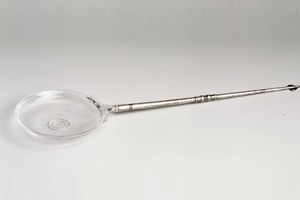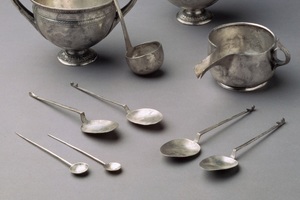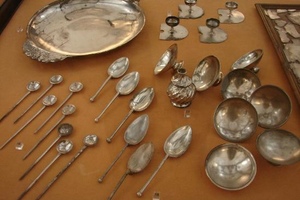Spoon
Spoon (Latin: cochlear) – a utensil used for eating, consisting of a handle and a rounded, concave part made of metal or wood. Typically, spoons were crafted from iron or precious alloys such as copper, silver, or gold. There were also elaborately decorated and folding variants.
The most ornate and complex antique spoons belong to Roman civilization. Folding mechanisms, as well as the combination of spoons with other eating tools (such as forks or knives), are characteristic of Roman craftsmanship.
In addition to folding spoons, there were also assembled spoon-knives. An example is the spoon with a panther from the Metropolitan Museum, New York, No. 17.192.254. It was made of a copper alloy with silver plating and niello. It measured 12.3x2.5x1.6 cm and was found in northern France. It is believed that a slot at the end of the handle was meant for inserting a blade, allowing it to function both as a spoon and a knife.
Roman spoons were made from a variety of materials, depending on the wealth and status of their owners. The most common were iron and bronze spoons, used by ordinary citizens and soldiers. Wealthier Romans could afford spoons made of silver or even gold. These spoons often featured rich decorative elements, highlighting the status of their owners.
Wooden spoons were also widespread, particularly among the less affluent. Wooden spoons were inexpensive to produce, but their durability was inferior to that of their metal counterparts. Some spoons were made of bone or ivory, adding a certain elegance to them.
Spoons in Ancient Rome came in various shapes and sizes, adapted for different culinary purposes:
- Cochlear – the most common type of spoon, had a small, slightly oval or rounded bowl and a long thin handle. It was used for eating, especially liquid foods like soups and porridges. In some cases, the handle of the cochlear ended in a pointed tip, which allowed it to be used for extracting food from shellfish or eggs.
- Ligula – a larger and deeper version of the spoon, resembling modern table spoons. It was used for eating solid or thick dishes. The ligula often had a short and wide handle, making it convenient to use.
- Cochlearum auri – golden spoons, intended for aristocracy and wealthy citizens. These spoons could be richly decorated with engravings, inlays, or even precious stones.
- Folding spoons – a special type of spoon that could be folded for easy transportation. Such spoons were used by travelers or soldiers who needed compact and practical utensils.
Spoons in Ancient Rome were used not only for eating but also for other purposes. For example, small spoons were often used for measuring medicinal substances, spices, or other small kitchen ingredients. Spoons with pointed handles could be used for piercing fruit or extracting food from small containers.
Roman spoons were an important element of table setting, especially in the homes of noble Romans, where dining traditions were cultivated to an art form. Spoons, like other tableware, reflected the host's status and could be a source of pride.
Spoons are often depicted in ancient Roman frescoes, mosaics, and reliefs, indicating their significance in daily life. During archaeological excavations in Pompeii and Herculaneum, many spoons were found, many of which were well-preserved due to volcanic deposits. These findings give us an idea of the diversity of forms and materials of spoons used in Ancient Rome.
One of the most interesting archaeological artifacts are silver spoons with inlays found in the tombs of noble Romans. These spoons not only served a utilitarian purpose but also symbolized wealth and status.
Related topics
Ancient military campaigns, Fork, Knife

 Gallery
Gallery






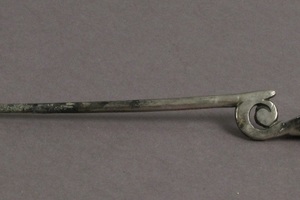 Roman spoon. 18.9 x 2.9 x 1.6 cm. Copper-silver alloy. The Metropolitan Museum of Art, New York. No. 17.191.211. 4th-5th century AD.
Roman spoon. 18.9 x 2.9 x 1.6 cm. Copper-silver alloy. The Metropolitan Museum of Art, New York. No. 17.191.211. 4th-5th century AD.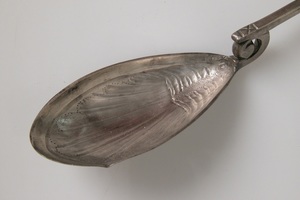 Roman spoon. 18.9 x 2.9 x 1.6 cm. Copper-silver alloy. The Metropolitan Museum of Art, New York. No. 17.191.211. 4th-5th century AD.
Roman spoon. 18.9 x 2.9 x 1.6 cm. Copper-silver alloy. The Metropolitan Museum of Art, New York. No. 17.191.211. 4th-5th century AD.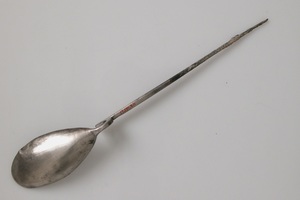 Roman spoon. 18.9 x 2.9 x 1.6 cm. Copper-silver alloy. The Metropolitan Museum of Art, New York. No. 17.191.211. 4th-5th century AD.
Roman spoon. 18.9 x 2.9 x 1.6 cm. Copper-silver alloy. The Metropolitan Museum of Art, New York. No. 17.191.211. 4th-5th century AD.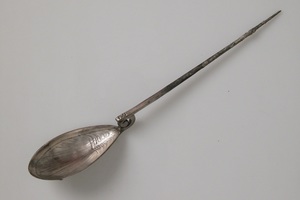 Roman spoon. 18.9 x 2.9 x 1.6 cm. Copper-silver alloy. The Metropolitan Museum of Art, New York. No. 17.191.211. 4th-5th century AD.
Roman spoon. 18.9 x 2.9 x 1.6 cm. Copper-silver alloy. The Metropolitan Museum of Art, New York. No. 17.191.211. 4th-5th century AD.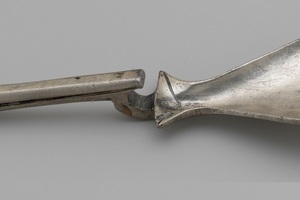 Roman silver spoon. 10.6 cm. The Metropolitan Museum of Art, New York. No. 19.192.64. 3rd century AD.
Roman silver spoon. 10.6 cm. The Metropolitan Museum of Art, New York. No. 19.192.64. 3rd century AD.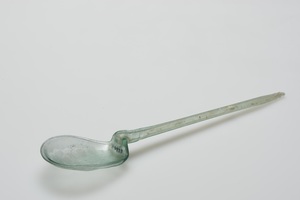 Glass spoon. 19.1 cm. Eastern Mediterranean. The State Hermitage Museum. No. GR-10139. Purchased from Sivajan in 1898. 2nd-3rd century AD.
Glass spoon. 19.1 cm. Eastern Mediterranean. The State Hermitage Museum. No. GR-10139. Purchased from Sivajan in 1898. 2nd-3rd century AD.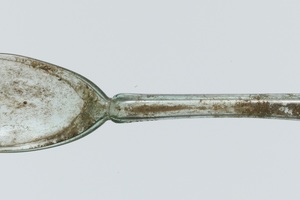 Roman glass spoon. 18.41 x 4.12 cm. Found near Nazareth. The Metropolitan Museum of Art, New York. No. 15.43.235. 1st-3rd century AD.
Roman glass spoon. 18.41 x 4.12 cm. Found near Nazareth. The Metropolitan Museum of Art, New York. No. 15.43.235. 1st-3rd century AD.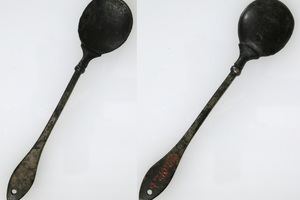 Roman bronze spoon. Made in Gaul. 11.9 x 2.6 x 0.6 cm. The Metropolitan Museum of Art, New York. No. 47.107.2. 1st-4th century AD.
Roman bronze spoon. Made in Gaul. 11.9 x 2.6 x 0.6 cm. The Metropolitan Museum of Art, New York. No. 47.107.2. 1st-4th century AD.